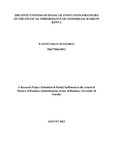| dc.description.abstract | The purpose of this study was to determine the effectiveness of financial innovation
strategies on the financial performance of the commercial banks in Kenya. In
addition, the study sought to classify those commercial banks that have been effective
in financial innovation against those commercial banks that have been less effective in
financial innovation on the basis of a given set of discriminating variables. This study
adopted a cross-sectional descriptive survey research design where the population for
the study consisted of all the 43 commercial banks in Kenya as provided by the
Central Bank of Kenya's Bank Supervision Annual Report, 2012. The data for
analysis was derived from mainly secondary data sources including official CBK
publications and the relevant financial statements for the commercial banks in Kenya.
The findings from the regression analysis show that the model was able to explain
only 23% of the variations in the financial performance of the commercial banks in
Kenya with the rest being explained by other factors not captured by the study.
Furthermore, process innovation had a positive significant effect on the financial
performance for the banks while product innovation and the proportion of net profit
set aside for financial innovation had a negative impact on the financial performance
of the commercial banks. The findings from the discriminant analysis revealed that
the return on net assets is the most important in classifying commercial banks that
have been effective in financial innovation against those commercial banks that have
been less effective in financial innovation. This implies that the return on net assets
had the greatest discriminating power out of all the discriminating variables used in
the analysis. The classification results indicate that of the 20 commercial banks
initially classified as being effective in financial innovation, 17 banks (85%) were
correctly classified by the discriminant model while 3 banks (15%) were classified
incorrectly by the model. Additionally, of the 21 commercial banks initially classified
as being less effective in financial innovation, 19 banks (90.5%) were correctly
classified by the discriminant model while 2 banks (9.5%) were classified incorrectly
by the model. The study also found that the discriminant model was significantly
reliable for prediction. On the basis of the study results, the paper concludes that the
mixed results derived from the relationship between financial performance and
financial innovation necessitates the need to put in place a formal risk management
framework so as to mitigate against the adverse effects of financial innovation. The
paper also recommends that prior to any financial innovation strategy being
implemented it should be preceded by a structured cost benefit analysis so as to
ensure that the investments funds allocated for innovation provide a good return and
benefit for the commercial banks. The study draws a discussion of the results from
both a theoretical perspective where the paper notes that the wealth induced
innovation theory is supported by the results from the discriminant analysis while the
transaction cost innovation theory is supported by the results from the regression
analysis and the practical perspective of the results which attempts to provide a real
life explanation of the results of the study. Finally, the paper admits that the study
faced a few challenges such as the blurred definition between product and process
innovation but ultimately all the limitations were mitigated effectively. Suggestions
for further research were laid down just to underlie the extensive scope for this study
and numerous opportunities for the research questions that still remain unanswered. | en_US |

